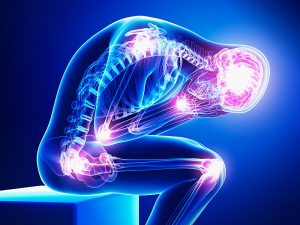I’ve written at length in the past about different aspects of acute and chronic pain as it relates to musculoskeletal injuries.
One specific area under the pain umbrella that I’ve not discussed in detail is how your nervous system changes and becomes more sensitive when you hurt.
If you’ve been in pain for a long time, other body systems may become more sensitive to stimuli.
Here are some ways in which your nervous system responds to different internal and external stimuli when your pain levels are elevated:
Temperature
Believe or not, there are temperature sensors in your nerves! When you get cold, it is normal to feel more aches and pains in the affected area. There are several patients I see for a tune-up every November before the weather turns colder in hopes that they have fewer aches when it starts to turn frosty.
Stress
Other sensors in the nerves are sensitive to the chemicals released into the body when we’re under stress. Higher levels of stress chemicals in the body increase the likelihood that higher pain levels are on their way. It is for this reason that a comprehensive pain management program almost always includes some kind of stress-relief training.
Motion and pressure
If you’ve ever had surgery, you may have noticed that moving the affected body area can be painful for awhile afterwards. This is because of pressure sensors in the nerves and is a normal part of the recovery process. With continued movement over time, the intensity of the pain decreases and you start to feel better as you return to normal activity.
Immunity
When your body is fighting illness, the nerve senses the immune chemicals circulating through your system and becomes more sensitive. When I’m working with a patient who has had a mild to moderate increase in pain for no apparent reason, I usually wonder if they’re fighting off a cold or the flu. More often than not, they cancel the subsequent appointment due to illness.
Blood Flow
Have you ever wondered why you feel so dang stiff after sitting for an extended period of time? Part of the reason is that your nerves can sense when blood flow is diminished. As a result, they become more sensitive for a few minutes after your start moving again.
Research has shown that when a person is educated in why they are having discomfort and how it can affect them, their pain actually diminishes.
A small study conducted in Australia by Lorimer Mosley provided some fascinating evidence of this phenomenon. A diagnostic tool called fMRI was used to measure activity in specific parts of the brain during a physical or cognitive task.
When the study subject was initially asked to perform a task, the areas in their brain responsible for pain immediately became very active. After completing 2 1/2 hours of pain education, the task was repeated.
This time, the areas which perceive pain were silent, and the subject did not report any pain.
The take-home message here is that knowledge is power. If you or someone you care about has been experiencing pain that is hard to cope with, ask your doctor for a referral to a physical therapist who has had extensive training in pain education and treatment.
Let us be your guide towards a life with less pain.








